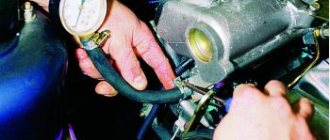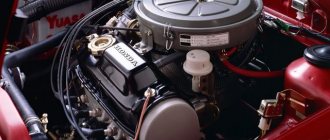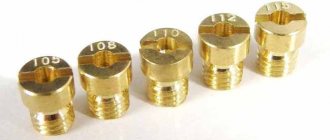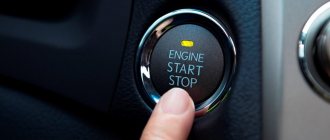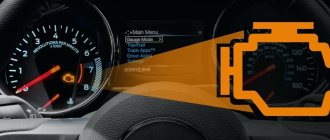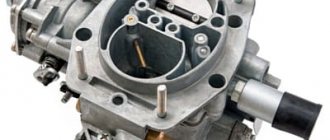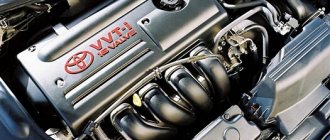Functions, structure and principle of operation
Each car is characterized by such a concept as “power reserve”. It is determined by the distance that a car can travel on a full fuel tank without additional refills. This indicator is influenced by a variety of factors: seasonal, weather and natural driving conditions, the nature of the road surface, the degree of vehicle load, the individual characteristics of the driver when driving, etc.). However, the main role in determining the “appetite” of a car is played by the power system and its proper operation.
The power system performs the following functions:
- fuel supply, cleaning and storage;
- air purification;
- preparing a special flammable mixture;
- supplying the mixture to the internal combustion engine cylinders.
The classic car power system consists of the following structural elements:
- a fuel tank designed to store fuel;
- a fuel pump that performs the functions of creating pressure in the system and forcing fuel supply;
- fuel lines - special metal tubes and rubber hoses for transporting fuel from the fuel tank to the internal combustion engine (and excess fuel in the opposite direction);
- fuel purification filter (or filters);
- air filter (to clean the air from impurities);
- devices for preparing the fuel-air mixture.
The power supply system has a fairly simple principle of operation: under the influence of a special fuel pump, fuel from the tank, having previously undergone a cleaning procedure with a fuel filter, is supplied through fuel lines to a device intended for preparing the fuel-air mixture. And only then the mixture is supplied to the engine cylinders.
Repair and replacement of fuel system prices
| Fuel system | |
| Replacing the gas tank | from 1,000 rub. |
| Replacing the air filter | from 200 rub. |
| Replacing additional fuel filter | from 500 rub. |
| Replacing the fuel sensor | from 800 rub. |
| Replacing the fuel pump | from 1,000 rub. |
| Replacing the fuel filter | from 500 rub. |
| Replacing the fuel pipe | from 500 rub. |
| Replacing the hose | from 500 rub. |
| Trouble-shooting | from 200 rub. |
| injector replacement | from 1,000 rub. |
| replacing the fuel filter | from 500 rub. |
| fuel system replacement | from 1,000 rub. |
| injector flushing | from 1,000 rub. |
| injector cleaning | from 1,000 rub. |
Car brands serviced
| Acura | Alfa Romeo | BID | Cherry | Chrysler | Citroen | Daewoo | Daihatsu | Dodge | FAU | Fiat | Ford | Photon | Gili | GMC | Great Wall | Honda | Hyundai | Infinity | Isuzu |
| Jeep | JMC | KIA | Lifan | Mazda | Mini | Mitsubishi | Nissan | Opel | Peugeot | Plymouth | Pontiac | Renault | SEAT | Skoda | SMART | Ssang Yong | Toyota | Volvo |
Sign up for service at our car service center
Call +7
Write to [email protected]
Come Varshavskoe highway, 170G
Power System Options
The main types of fuel for internal combustion engines are gasoline and diesel fuel (“diesel fuel”). Gas (methane) also belongs to the types of modern fuel, but, despite its widespread use, it has not yet become relevant. The type of fuel is one of the criteria for classifying internal combustion engine power systems.
In this regard, power units are distinguished:
- gasoline;
- diesel;
- based on gaseous fuel.
But the most recognized among experts is the typology of engine power systems based on the method of fuel supply and preparation of the fuel-air mixture. Following this classification principle, we distinguish, firstly, the power supply system of a carburetor engine, and secondly, the power supply system with fuel injection (or an injection engine).
Carburetor
The carburetor system is based on the operation of a technically complex device - a carburetor. A carburetor is a device that prepares a mixture of fuel and air in the required proportions. Despite the variety of types, in automotive practice the most widely used is the float suction carburetor, the circuit diagram of which includes:
- float chamber and float;
- atomizer, diffuser and mixing chamber;
- air and throttle valves;
- fuel and air channels with corresponding jets.
The preparation of the fuel-air mixture in the carburetor is carried out according to a passive scheme. The movement of the piston during the intake stroke (first stroke) creates a rarefied space in the cylinder, into which air rushes, passing through the air filter and through the carburetor. It is here that the formation of a combustible mixture occurs: in the mixing chamber, in the diffuser, the fuel escaping from the atomizer is crushed by the air flow and mixed with it. Finally, through the intake manifold and intake valves, the combustible mixture is supplied to a specific engine cylinder, where at the required moment it is ignited by a spark from the spark plug.
Thus, the power system of a carburetor engine is a predominantly mechanical method of preparing the fuel-air mixture.
Fuel injection
The era of the carburetor is being replaced by the era of the injection engine, the power system of which is based on fuel injection. Its main elements are: an electric fuel pump (located, as a rule, in the fuel tank), injectors (or nozzle), and an internal combustion engine control unit (the so-called “brains”).
The principle of operation of this power system is reduced to spraying fuel through nozzles under pressure created by the fuel pump. The quality of the mixture varies depending on the engine operating mode and is controlled by the control unit. An important component of such a system is the nozzle. The typology of injection engines is based precisely on the number of injectors used and their location.
Thus, experts tend to highlight the following injector options:
- with distributed injection;
- with central injection.
The distributed injection system involves the use of injectors according to the number of engine cylinders, where each cylinder is served by its own injector, which is involved in preparing the combustible mixture. The central injection system has only one injector for all cylinders, located in the manifold.
Diesel engine features
The operating principle on which the diesel engine power system is based stands out as if apart. Here, fuel is injected directly into the cylinders in atomized form, where the process of mixture formation (mixing with air) occurs, followed by ignition from compression of the combustible mixture by the piston. Depending on the fuel injection method, the diesel power unit is presented in three main options:
- with direct injection;
- with swirl chamber injection;
- with pre-chamber injection.
The swirl chamber and pre-chamber options involve injection of fuel into a special preliminary chamber of the cylinder, where it is partially ignited and then moved into the main chamber or the cylinder itself. Here the fuel mixes with air and finally burns out. Direct injection involves delivering fuel immediately into the combustion chamber and then mixing it with air, etc.
Another feature that distinguishes the diesel engine power system is the principle of ignition of the combustible mixture. This does not come from the spark plug (as in a gasoline engine), but from the pressure created by the cylinder piston, that is, by self-ignition. In other words, in this case there is no need to use spark plugs.
However, a cold engine will not be able to provide the proper temperature level required to ignite the mixture. And the use of glow plugs will allow for the necessary heating of the combustion chambers.
Car device
The concept of injection engines
Injection engines are engines with spark ignition of the fuel mixture, in which gasoline is used as fuel, and the mixture formation process occurs using a nozzle or nozzles that inject fuel under pressure into the intake manifold or into the engine cylinder.
Fuel injection instead of using the carburetion process has provided a number of specific benefits, so in recent years all power systems using injection are increasingly replacing carburetor engine power systems, especially in passenger cars.
The widespread use of fuel injection systems on trucks is currently hampered by their disadvantages, such as the increased complexity of maintenance and the high cost of the devices and components used. However, taking into account the undoubted advantages that make it possible to obtain tangible long-term benefits, it can be assumed that gasoline injection systems will find widespread use in trucks, especially light and medium-duty vehicles, in the coming years. In heavy-duty trucks and buses, there is no worthy competition for diesel engines yet.
Power system operating modes
Depending on the goals and road conditions, the driver can use different driving modes. They also correspond to certain operating modes of the power supply system, each of which has a special quality fuel-air mixture.
- The mixture will be rich when starting a cold engine. At the same time, air consumption is minimal. In this mode, the possibility of movement is categorically excluded. Otherwise, this will lead to increased fuel consumption and wear of power unit parts.
- The composition of the mixture will be enriched when using the “idling” mode, which is used when coasting or running the engine in a warm state.
- The mixture will be leaner when driving with partial loads (for example, on a flat road at medium speed in high gear).
- The mixture composition will be enriched at full load when the vehicle is moving at high speed.
- The mixture will be rich, close to rich, when driving under conditions of sharp acceleration (for example, when overtaking).
The choice of operating conditions for the power system, therefore, must be justified by the need to move in a certain mode.
Operating principle of the injector
The principle of operation of an injector in cars can be divided into two parts - the mechanical component and the electronic component.
- fuel tank;
- electric fuel pump;
- gasoline purification filter;
- high pressure fuel lines;
- fuel rail;
- nozzles;
- throttle assembly;
- air filter.
Malfunctions and service
During the operation of the vehicle, the vehicle's fuel system experiences loads that lead to its unstable operation or failure. The following faults are considered the most common.
Insufficient supply (or lack of supply) of fuel to the engine cylinders
Poor quality fuel, long service life, and environmental exposure lead to contamination and clogging of fuel lines, tank, filters (air and fuel) and technological openings of the combustible mixture preparation device, as well as breakdown of the fuel pump. The system will require repairs, which will consist of timely replacement of filter elements, periodic (every two to three years) cleaning of the fuel tank, carburetor or injector nozzles and replacement or repair of the pump.
Engine power loss
A malfunction of the fuel system in this case is determined by a violation of the regulation of the quality and quantity of the combustible mixture entering the cylinders. Troubleshooting involves the need to diagnose the combustible mixture preparation device.
Fuel leak
A fuel leak is a very dangerous phenomenon and is absolutely unacceptable. This malfunction is included in the “List of malfunctions...” with which the vehicle is prohibited from moving. The causes of the problems lie in the loss of tightness of the components and assemblies of the fuel system. Troubleshooting involves either replacing damaged system elements or tightening the fuel line fastenings.
Thus, the power system is an important element of the internal combustion engine of a modern car and is responsible for the timely and uninterrupted supply of fuel to the power unit.
What else is worth reading
VAZ 2109 generator device
The design of the chassis of the VAZ 2109
Intake manifold device
Fuel pump
Types and types of injectors
There are two types of injectors:
- With single point injection. This system is outdated and is no longer used on cars. Its essence is that there is only one nozzle, installed in the intake manifold. This design did not ensure uniform distribution of fuel throughout the cylinders, so its operation was similar to a carburetor system.
- Multipoint injection. Modern cars use this type. Here, each cylinder has its own nozzle, so this system is characterized by high dosage accuracy. Injectors can be installed both in the intake manifold and in the cylinder itself (direct injection system).
